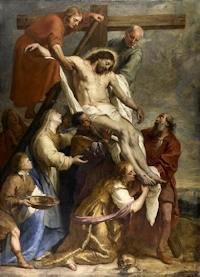Lent: March 12th
Saturday of the First Week of Lent
Other Commemorations: St. Luigi Orione, Priest (RM); St. Innocent I, Pope (RM)
» Enjoy our Liturgical Seasons series of e-books!
Gospel Verse, 2 Cor 6:2b:
Behold, now is a very acceptable time; behold, now is the day of salvation.
Today is Ember Saturday of the Lent or Spring Embertide. See Contemporary Observation of Ember Days and Lenten Ember Days for more information.
The traditional Station Church today is at St. Peter's Basilica. In this basilica at the Vatican priestly ordinations were formerly held on Ember Saturday, preceded by a long vigil. The 1962 Missal includes three extra Lessons, a relic of those read formerly during the night. The first reading from Deuteronomy 26:16-19 is one of the readings from the former missal.
In the previous calendar (1962) today is the commemoration of Pope St. Gregory the Great. His feast in the current calendar is celebrated on September 3.
The Roman Martyrology commemorates St. Luigi Giovanni Orione, F.D.P. (also known as Aloysius). He was an Italian priest who was active in answering the social needs of his nation as it faced the social upheavals of the late 19th century. To this end, he founded a religious institute of men. St. Luigi was canonized by St. John Paul II on May 16, 2004.
It is also the commemoration of St. Innocent I, pope of the early Church. St. Innocent I (401-417), a contemporary of St. Augustine and St. Jerome, was one of the greatest early popes. He was one of the great champions of the primacy of the Holy See.
Meditation on the Liturgy—Spring Ember Days
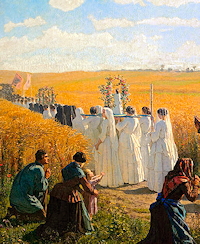 According to the tradition of the Church, the first week of Lent is the week of Spring Ember Days. Ember Days are specifically a tradition of the Church in Rome, its roots partly to be found in the Old Testament — where for example the prophet Zechariah attests four seasons of fasting in the years — and partly in the tradition of pagan Rome, with its festivals of seedtime and harvest still recalled in our own days. So we have this fine combination of creation and biblical history, a combination which is a sign of true catholicity. In the celebrations of these days we receive the year from the hand of God, receive our time from the Creator and Redeemers, and confide sowing and harvesting to his goodness, thanking him for the fruit of the earth and our work. The celebration of the Ember Days corresponds to the fact that "the creating waits with eager longing for the revealing of the sons of God" (Rom 8:19): through our prayer, creation enters into the Eucharist, has part in the praise of God.
According to the tradition of the Church, the first week of Lent is the week of Spring Ember Days. Ember Days are specifically a tradition of the Church in Rome, its roots partly to be found in the Old Testament — where for example the prophet Zechariah attests four seasons of fasting in the years — and partly in the tradition of pagan Rome, with its festivals of seedtime and harvest still recalled in our own days. So we have this fine combination of creation and biblical history, a combination which is a sign of true catholicity. In the celebrations of these days we receive the year from the hand of God, receive our time from the Creator and Redeemers, and confide sowing and harvesting to his goodness, thanking him for the fruit of the earth and our work. The celebration of the Ember Days corresponds to the fact that "the creating waits with eager longing for the revealing of the sons of God" (Rom 8:19): through our prayer, creation enters into the Eucharist, has part in the praise of God.
In the fifth century however, the Ember Days took on another dimension, becoming feasts of the spiritual harvest of the Church, feasts of Holy Orders. The arrangement of stational churches for these three days is very significant: Wednesday, Saint Mary Major; Friday, the Church of the Twelve Apostles; Saturday, St. Peter's. On the first day, the Church presented the ordinands to Our Lady, to the Church in person. "Sub tuum praesidium confugimus" (We fly to your protection), a Marian prayer of the third century, comes to mind here when we meditate on this action. The Church confides her ministers to the Mother: "Behold your mother". This word from the Cross encourages us to seek refuge close to our Mother. Under Our Lady's mantle, we are safe. In all our difficulties we can turn with immense faith to our Mother, we venture to take up our service.
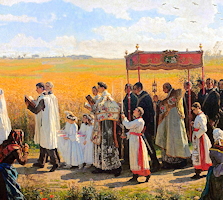 The Friday was the day of the Twelve Apostles' church. As "fellow-citizens of the saints and servants of God" we "are built upon the foundation of the apostles and prophets" (Eph 2:19-20). Only in the context of the apostolic succession, of the faith of the Apostles and of the apostolic structure of the Church, with a true priestly system, that is, can we construct the living temple of God. The ordinations themselves took place during the night of Saturday, with a view to Sunday morning in St. Peter's. Thus the Church expressed the unity of the priestly system in union with Peter, as Jesus at the beginning of his public life had called Peter and his "partners" (Lk 5:10), after he had been teaching from Simon's boat.
The Friday was the day of the Twelve Apostles' church. As "fellow-citizens of the saints and servants of God" we "are built upon the foundation of the apostles and prophets" (Eph 2:19-20). Only in the context of the apostolic succession, of the faith of the Apostles and of the apostolic structure of the Church, with a true priestly system, that is, can we construct the living temple of God. The ordinations themselves took place during the night of Saturday, with a view to Sunday morning in St. Peter's. Thus the Church expressed the unity of the priestly system in union with Peter, as Jesus at the beginning of his public life had called Peter and his "partners" (Lk 5:10), after he had been teaching from Simon's boat.
The first week of Lent is a week of seedtime: let us entrust to God's goodness the fruits of the earth and the work of human hands, so that all may receive daily bread, so that hunger may be taken from the earth. Let us entrust to God's goodness also the seed of the word, so as to revive in ourselves the gift of God which is in us "through the laying-on of the hands" of the bishop (2 Tim 1:6), in the apostolic succession, in union with Peter. Let us thank God who has protected us in all temptations and difficulties, and pray, in the words of the prayer after Communion, that God will extend to us his favor, that is, his eternal love, himself, the gift of the Holy Spirit, and that he will grant us also the temporal consolations that we need in our weakness:
"You have strengthened us Lord, through these mysteries and nourished us with your heavenly sacrament. Stay with us to comfort us and save us, and never cease to show us your favour".Let us make our prayer "through Christ our Lord". Let us pray as under our Mother's mantle. Let us pray as trustful children. The word of the Redeemer stands firm: "Have faith—I have overcome the world" (Jn 16:33).
—Cardinal Joseph Ratzinger (Pope Benedict XVI), Journey Towards Easter
St. Luigi Orione
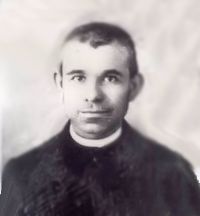 Luigi Orione was born in Pontecurone, diocese of Tortona, on 23 June 1872. At thirteen years of age he entered the Franciscan Friary of Voghera (Pavia), but he left after one year owing to poor health. From 1886 to 1889 he was a pupil of Saint John Bosco at the Valdocco Oratory (Youth Centre) in Turin.
Luigi Orione was born in Pontecurone, diocese of Tortona, on 23 June 1872. At thirteen years of age he entered the Franciscan Friary of Voghera (Pavia), but he left after one year owing to poor health. From 1886 to 1889 he was a pupil of Saint John Bosco at the Valdocco Oratory (Youth Centre) in Turin.
On 16 October 1889, he joined the diocesan seminary of Tortona. As a young seminarian he devoted himself to the care of others by becoming a member of both the San Marziano Society for Mutual Help and the Society of Saint Vincent de Paul. On 3 July 1892 he opened the first Oratory in Tortona to provide for the Christian training of boys. The following year, on 15 October 1893, Luigi Orione, then a seminarian of twenty-one, started a boarding school for poor boys, in the Saint Bernardine estate.
On 13 April 1895, Luigi Orione was ordained priest and, on that occasion, the Bishop gave the clerical habit to six pupils of the boarding school. Within a brief span of time, Don Orione opened new houses at Mornico Losana (Pavia), Noto - in Sicily, Sanremo and Rome.
Around the young Founder there grew up seminarians and priests who made up the first core group of the Little Work of Divine Providence. In 1899, he founded the branch of the Hermits of Divine Providence. The Bishop of Tortona, Mgr Igino Bandi, by a Decree of 21 March 1903, issued the canonical approval of the Sons of Divine Providence (priests, lay brothers and hermits) - the male congregation of the Little Work of Divine Providence. It aims to "co-operate to bring the little ones, the poor and the people to the Church and to the Pope, by means of the works of charity," and professes a fourth vow of special "faithfulness to the Pope." In the first Constitutions of 1904, among the aims of the new Congregation, there appears that of working to "achieve the union of the separated Churches."
Inspired by a profound love for the Church and for the salvation of Souls, he was actively interested in the new problems of his time, such as the freedom and unity of the Church, the Roman question, modernism, socialism and the Christian evangelization of industrial workers.
He rushed to assist the victims of the earthquakes of Reggio and Messina (1908) and the Marsica region (1915). By appointment of Saint Pius X, he was made Vicar General of the diocese of Messina for three years.
On 29 June 1915, twenty years after the foundation of the Sons of Divine Providence, he added to the "single tree of many branches" the Congregation of the Little Missionary Sisters of Charity who are inspired by the same founding charism. Alongside them, he placed the Blind Sisters, Adorers of the Blessed Sacrament. Later, the Contemplative Sisters of Jesus Crucified were also founded.
For lay people he set up the associations of the "Ladies of Divine Providence," the "Former Pupils," and the "Friends." More recently, the Don Orione Secular Institute and the Don Orione Lay People's Movement have come into being.
Following the First World War (1914-1918), the number of schools, boarding houses, agricultural schools, charitable and welfare works increased. Among his most enterprising and original works, he set up the "Little Cottolengos," for the care of the suffering and abandoned, which were usually built in the outskirts of large cities to act as "new pulpits" from which to speak of Christ and of the Church - "true beacons of faith and of civilization."
Don Orione's missionary zeal, which had already manifested itself in 1913 when he sent his first religious to Brazil, expanded subsequently to Argentina and Uruguay (1921), Palestine (1921), Poland (1923), Rhodes (1925), the USA (1934), England (1935), Albania (1936). From 1921-1922 and from 1934-1937, he himself made two missionary journeys to Latin America: to Argentina, Brazil and Uruguay, going as far as Chile.
He enjoyed the personal respect of the Popes and the Holy See's Authorities, who entrusted him with confidential tasks of sorting out problems and healing wounds both inside the Church as well as in the relations with society. He was a preacher, a confessor and a tireless organizer of pilgrimages, missions, processions, live cribs and other popular manifestations and celebrations of the faith. He loved Our Lady deeply and fostered devotion to her by every means possible and, through the manual labor of his seminarians, built the shrines of Our Lady of Safe Keeping in Tortona and Our Lady of Caravaggio at Fumo. In the winter of 1940, with the intention of easing the heart and lung complaints that were troubling him, he went to the Sanremo house, even though, as he said, "it is not among the palm trees that I would like to die, but among the poor who are Jesus Christ." Only three days later, on 12 March 1940, surrounded by the love of his confreres, Don Orione died, while sighing "Jesus, Jesus! I am going."
His body was found to be intact at its first exhumation in 1965. It has been exposed to the veneration of the faithful in the shrine of Our Lady of Safe Keeping in Tortona ever since 26 October 1980 - the day in which Pope John Paul II inscribed Don Luigi Orione in the Book of the Blessed. He was canonized on 16 May 2004.
—© Libreria Editrice Vaticana
Highlights and Things to Do:
- Read more about St. Luigi Orione:
- Find out more about The Sons of Divine Providence, the order founded by St. Luigi, and their work, Orionecare. See also the Italian main site.
- St. Luigi's body was found intact when exhumed in 1965. His remains are now interred at the shrine of Our Lady of Safe Keeping, Tortona, Italy.
St. Innocent I
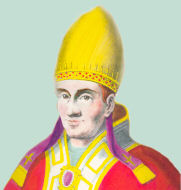 Innocent was born in Albano, Italy. He lived during the time of Saints Jerome and Augustine. He became Pope, on December 22, 401. Jerome, writing to the virgin Demetrias, says of him: "Hold fast to the faith of holy Innocent, who is the son of Anastasius of blessed memory and his successor in the apostolic throne; receive no strange doctrine, however shrewd and prudent you may think yourself."
Innocent was born in Albano, Italy. He lived during the time of Saints Jerome and Augustine. He became Pope, on December 22, 401. Jerome, writing to the virgin Demetrias, says of him: "Hold fast to the faith of holy Innocent, who is the son of Anastasius of blessed memory and his successor in the apostolic throne; receive no strange doctrine, however shrewd and prudent you may think yourself."
During his pontificate, Innocent emphasized papal supremacy, praising the bishops of Africa for referring the decrees of their councils at Carthage and Milevis in 416 that condemned Pelagianism, to the pope for confirmation. This confirmation stirred St. Augustine to pen his famous remark: "Roma locuta, causa finita est" (Rome has spoken, the matter is ended).
Innocent was pope during the capture and sack of Rome by the Goths under Alaric in 410. He condemned the heresies of Pelagius and Celestinus, decreeing that children, even though born of a Christian mother, must be born again by water, in order that their second birth may cleanse away the stain they have contracted by the first. He also approved the observance of fasting on the Saturday in memory of the burial of Christ our Lord. He fought the unjust removal of Saint John Chrysostom and spoke strongly in favor of clerical celibacy. He sat fifteen years, one month, and ten days. Innocent died in Rome, March 12, 417 and was buried in the cemetery called ad Ursum Pileatum.
—Some material excerpted from The Liturgical Year, Abbot Gueranger O.S.B.
Symbols and Representation: Angel holding a crown.
Highlights and Things to Do:
- Read four letters of Correspondence between Innocent and Saint John Chrysostom.
- Read more about St. Innocent I:


